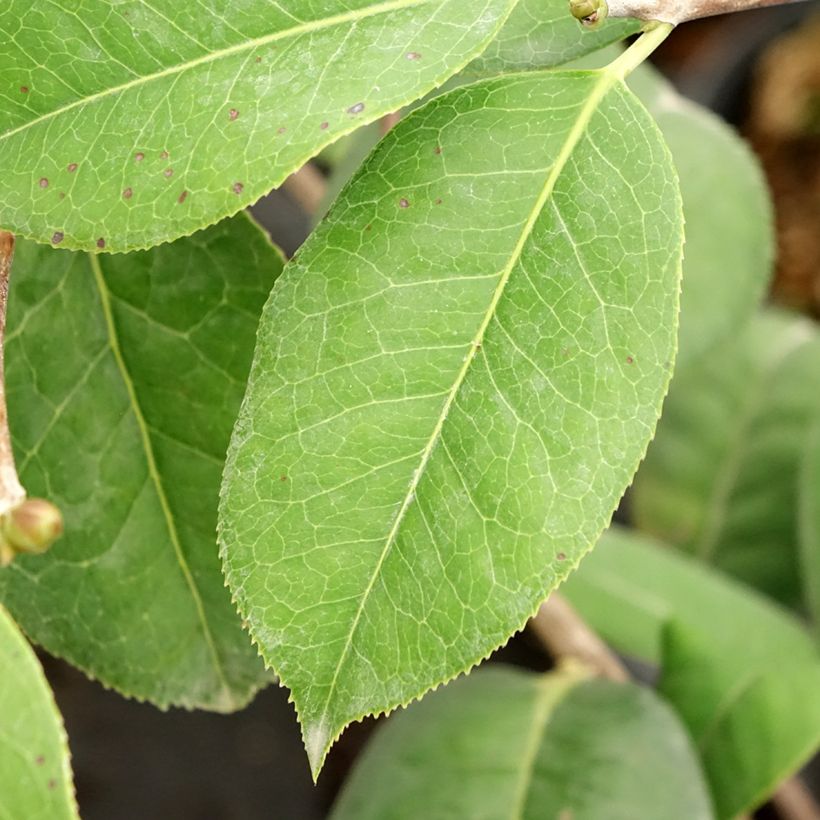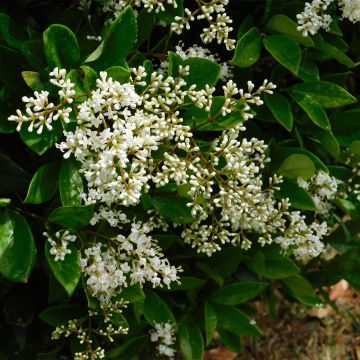

Camellia x reticulata Dr Clifford Parks
Camellia x reticulata Dr Clifford Parks
Camellia x reticulata Dr Clifford Parks
Special offer!
Receive a €20 voucher for any order over €90 (excluding delivery costs, credit notes, and plastic-free options)!
1- Add your favorite plants to your cart.
2- Once you have reached €90, confirm your order (you can even choose the delivery date!).
3- As soon as your order is shipped, you will receive an email containing your voucher code, valid for 3 months (90 days).
Your voucher is unique and can only be used once, for any order with a minimum value of €20, excluding delivery costs.
Can be combined with other current offers, non-divisible and non-refundable.
Home or relay delivery (depending on size and destination)
Schedule delivery date,
and select date in basket
This plant carries a 24 months recovery warranty
More information
We guarantee the quality of our plants for a full growing cycle, and will replace at our expense any plant that fails to recover under normal climatic and planting conditions.
Would this plant suit my garden?
Set up your Plantfit profile →
Description
The Camellia reticulata 'Dr Clifford Parks' is an exceptional variety due to the size of its flowers. Growing quite vigorously, it gradually forms a large bush with dark, glossy evergreen foliage that provides a perfect setting for the flowering display. From February onwards, the floral buds open to reveal semi-double flowers with intricate petals, reaching up to 15 cm in diameter. The undulating petals in a bright red shade contrast beautifully with the golden stamens, creating a colourful and stunning display. Undoubtedly one of the most beautiful bushes to welcome spring in the garden, it thrives in cool and moist conditions, shielded from intense sunlight by a canopy of vegetation.
The Camellia belongs to the Theaceae family, renowned for the tea produced from the leaves of Camellia sinensis. This plant family comprises about ten genera, including some ornamental ones such as x Gordlinia, a hybrid between the Gordonia and Franklinia genera, or the Stewartia whose flowers clearly show their relation to Camellias. The Camellia genus is very diverse, with classifications varying from about a hundred to 250 species, originating from Asia. Beloved by the Japanese and many garden enthusiasts, this plant also inspires professional breeders, resulting in the existence of around 40,000 varieties today!
'Dr Clifford Parks' hails from the United States where it first bloomed in 1970, before being registered as a new variety in 1972. It is a cross between Camellia japonica 'Kramer's Supreme', a large variety with cherry red peony-like flowers, and Camellia reticulata 'Crimson Robe', an old variety from 1948 with carmine red flowers and yellow centres. While Camellia japonica originates from Japan and Korea, where it grows as a small tree reaching 8 to 10 m in height, Camellia reticulata thrives in China, specifically in the Yunnan province, in mountainous regions at altitudes of 2000 to 3000 m, reaching the same size as C. japonica.
'Dr Clifford Parks' Camellia reticulata exhibits a much more modest growth pattern, as even though its growth is relatively vigorous and quite rapid, after 10 years of cultivation it will form a bush approximately 2 m tall and 1.50 m wide, reaching 3 m by 2.50 m at maturity, or slightly more in favourable conditions. The elliptical-shaped leaves, measuring about ten centimetres in length, have finely serrulate margins. Thin and leathery, they emerge in bronze tones before turning dark green, with a glossy appearance. Evergreen, they remain decorative throughout the seasons and particularly enhance nearby light blooms. They also provide a dark backdrop for the bush's own flowers. These flowers bloom from February to April, creating a spectacle in the garden with their unusually large dimensions, reaching up to 15 cm in diameter for the largest ones! Their appearance exudes a certain romanticism, with a shape between an "anemone flower" and a "peony flower" commonly used to describe Camellias. The undulating petals, in a bright red slightly leaning towards orange, seem to dance with the golden stamen, providing a stunning display in late winter and early spring.
'Dr Clifford Parks' Camellia is one of the most spectacular bushes to celebrate the end of winter and the beginning of the beautiful season. To create a stunning winter scene, you can pair it with Hamamelis, or Witch Hazels, whose curious filament-like flowers in yellow, red, or orange hues bloom as early as December in some varieties. The Stachyurus praecox, unfairly underrated, will enchant you at the same time with its long clusters of small yellow bell-shaped flowers, while its foliage beautifully turns red and orange in autumn. And to cover the ground in the loveliest way, plant some clumps of Ostrich Fern (Matteucia struthiopteris) with its stunningly cut fronds in a beautiful light green shade.
Report an error about the product description
Camellia x reticulata Dr Clifford Parks in pictures


Plant habit
Flowering
Foliage
Botanical data
Camellia
x reticulata
Dr Clifford Parks
Theaceae
Cultivar or hybrid
Planting and care
The Camellia 'Dr Clifford Parks' accepts full sun in a favourable climate, such as in Atlantic regions, but it thrives in partial shade, protected from the scorching sun and especially in a sheltered position away from strong winds. Plant it in a cool, humus-bearing, acidic, and well-drained soil. The bush should not be planted too deeply, the top of the root ball should be covered with 3 cm of soil. In winter, cover it with a 5 to 7 cm thick mulch composed of leaf compost and shredded bark. Beware of late frosts that can damage the flowers and buds. During dry periods, water the bush to prevent the dropping of flower buds. It is recommended to plant the camellia preferably in autumn to promote good root growth and better flowering from the first year. Possible diseases include chlorosis caused by excess limestone, brown spots caused by burns on leaves exposed to the south, sooty mould, scale insects, and vine-plant weevils.
Pruning is not necessary, it should be done if needed just after flowering, before the emergence of new spring shoots, and sparingly. Most camellia hybrids do not recover from overly severe pruning.
Planting period
Intended location
Care
This item has not been reviewed yet - be the first to leave a review about it.
Similar products
Haven't found what you were looking for?
Hardiness is the lowest winter temperature a plant can endure without suffering serious damage or even dying. However, hardiness is affected by location (a sheltered area, such as a patio), protection (winter cover) and soil type (hardiness is improved by well-drained soil).

Photo Sharing Terms & Conditions
In order to encourage gardeners to interact and share their experiences, Promesse de fleurs offers various media enabling content to be uploaded onto its Site - in particular via the ‘Photo sharing’ module.
The User agrees to refrain from:
- Posting any content that is illegal, prejudicial, insulting, racist, inciteful to hatred, revisionist, contrary to public decency, that infringes on privacy or on the privacy rights of third parties, in particular the publicity rights of persons and goods, intellectual property rights, or the right to privacy.
- Submitting content on behalf of a third party;
- Impersonate the identity of a third party and/or publish any personal information about a third party;
In general, the User undertakes to refrain from any unethical behaviour.
All Content (in particular text, comments, files, images, photos, videos, creative works, etc.), which may be subject to property or intellectual property rights, image or other private rights, shall remain the property of the User, subject to the limited rights granted by the terms of the licence granted by Promesse de fleurs as stated below. Users are at liberty to publish or not to publish such Content on the Site, notably via the ‘Photo Sharing’ facility, and accept that this Content shall be made public and freely accessible, notably on the Internet.
Users further acknowledge, undertake to have ,and guarantee that they hold all necessary rights and permissions to publish such material on the Site, in particular with regard to the legislation in force pertaining to any privacy, property, intellectual property, image, or contractual rights, or rights of any other nature. By publishing such Content on the Site, Users acknowledge accepting full liability as publishers of the Content within the meaning of the law, and grant Promesse de fleurs, free of charge, an inclusive, worldwide licence for the said Content for the entire duration of its publication, including all reproduction, representation, up/downloading, displaying, performing, transmission, and storage rights.
Users also grant permission for their name to be linked to the Content and accept that this link may not always be made available.
By engaging in posting material, Users consent to their Content becoming automatically accessible on the Internet, in particular on other sites and/or blogs and/or web pages of the Promesse de fleurs site, including in particular social pages and the Promesse de fleurs catalogue.
Users may secure the removal of entrusted content free of charge by issuing a simple request via our contact form.
The flowering period indicated on our website applies to countries and regions located in USDA zone 8 (France, the United Kingdom, Ireland, the Netherlands, etc.)
It will vary according to where you live:
- In zones 9 to 10 (Italy, Spain, Greece, etc.), flowering will occur about 2 to 4 weeks earlier.
- In zones 6 to 7 (Germany, Poland, Slovenia, and lower mountainous regions), flowering will be delayed by 2 to 3 weeks.
- In zone 5 (Central Europe, Scandinavia), blooming will be delayed by 3 to 5 weeks.
In temperate climates, pruning of spring-flowering shrubs (forsythia, spireas, etc.) should be done just after flowering.
Pruning of summer-flowering shrubs (Indian Lilac, Perovskia, etc.) can be done in winter or spring.
In cold regions as well as with frost-sensitive plants, avoid pruning too early when severe frosts may still occur.
The planting period indicated on our website applies to countries and regions located in USDA zone 8 (France, United Kingdom, Ireland, Netherlands).
It will vary according to where you live:
- In Mediterranean zones (Marseille, Madrid, Milan, etc.), autumn and winter are the best planting periods.
- In continental zones (Strasbourg, Munich, Vienna, etc.), delay planting by 2 to 3 weeks in spring and bring it forward by 2 to 4 weeks in autumn.
- In mountainous regions (the Alps, Pyrenees, Carpathians, etc.), it is best to plant in late spring (May-June) or late summer (August-September).
The harvesting period indicated on our website applies to countries and regions in USDA zone 8 (France, England, Ireland, the Netherlands).
In colder areas (Scandinavia, Poland, Austria...) fruit and vegetable harvests are likely to be delayed by 3-4 weeks.
In warmer areas (Italy, Spain, Greece, etc.), harvesting will probably take place earlier, depending on weather conditions.
The sowing periods indicated on our website apply to countries and regions within USDA Zone 8 (France, UK, Ireland, Netherlands).
In colder areas (Scandinavia, Poland, Austria...), delay any outdoor sowing by 3-4 weeks, or sow under glass.
In warmer climes (Italy, Spain, Greece, etc.), bring outdoor sowing forward by a few weeks.








































